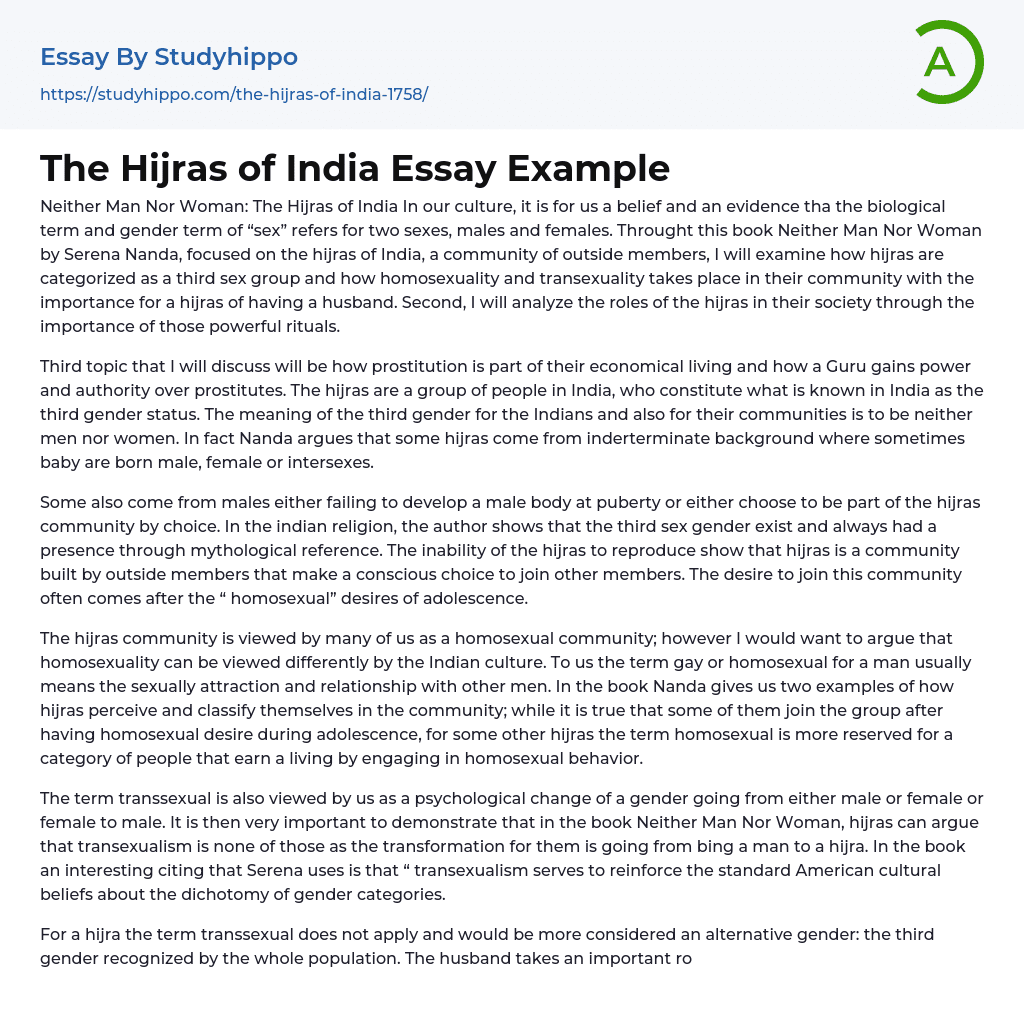The book "Neither Man Nor Woman" by Serena Nanda delves into the lives of the hijras of India, a community of individuals who fall outside the traditional categories of male and female. This text aims to explore the categorization of hijras as a distinct third sex, as well as the presence of homosexuality and transexuality within their community. Additionally, it examines the significance of having a husband for hijras and analyzes their societal roles through the lens of powerful rituals.
This text discusses two interconnected aspects: the role of prostitution in the economic livelihood of hijras in India, and how a Guru attains power and authority over prostitutes. The hijras, who are considered the third gender in India, do not identify as either men or women. According to Nanda, some hijras have ambiguous backgrounds, where babies are born as
...males, females, or intersex individuals.
Some hijras are males who either fail to develop a male body during puberty or choose to be part of the hijras community willingly. The author highlights in the Indian religion that the existence of a third gender has always been acknowledged and referenced in mythology. The fact that hijras cannot reproduce showcases that this community is formed by individuals who consciously decide to join others. The decision to join this community often arises from the adolescent experience of "homosexual" desires.
Many of us perceive the hijras community as a group of homosexuals. However, I would like to argue that the Indian culture can view homosexuality in a different way. To us, being gay or homosexual for a man typically refers to his sexual attraction and relationships with other men. In Nanda's book, tw
examples are given to show how hijras perceive and classify themselves within the community. While it is true that some hijras join the group after experiencing homosexual desires during adolescence, others reserve the term homosexual for individuals who earn a living through engaging in homosexual behavior.
The term transsexual refers to a psychological change in gender, transitioning from either male to female or from female to male. In the book Neither Man Nor Woman, hijras argue that their transformation is distinct from traditional transsexualism as they go from being a man to a hijra. The book cites Serena's observation that transsexualism reinforces cultural beliefs in the gender binary.
For a hijra, the term transsexual is not applicable and they are rather considered an alternative gender: the third gender recognized by the entire population. The husband plays a significant role in this regard, regardless of occasional ridicule. In the event of the birth of a new male child, hijras have more influence over couples to demonstrate fertility in terms of male offspring. Hijras have crucial roles in traditional ceremonies, such as both births and wedding ceremonies.
The hijra's relations with Indian goddesses give them power and authority over couples, although they might face mockery because not all Indians respect their community. However, fear is always present due to mythology that depicts the hijra's control over the fertility of newcomers. These rituals and traditions also serve as a significant source of income, allowing them to receive goods and money. This economic aspect is one of their main modes of living.
Prostitution is another crucial economic resource that the Hijra community considers significant. It is worth noting that prostitution for Hijra is
a means of secure income for their families, chosen when rituals and dance alone do not provide sufficient means for a better livelihood. Although the population generally holds a negative view of prostitution, Sushila, a prostitute Hijra, argues that it is preferable to begging on the streets for alms as it is not considered a cultural tradition in places like Bombay.
Gurus, who are admired for their wisdom, intellectual capacity, and strong sense of respect and responsibility, hold a form of power and authority among the Hijra community, similar to that of a manager. Other Hijra individuals work under a guru and earn a portion of their income from prostitution and contributing to ritual dances. Nanda emphasizes that being a guru requires specific skills, such as initiative, assertiveness, financial management, and a willingness to exploit others' labor. In conclusion, understanding these aspects provides insight into how a community, which differs greatly from Western society, is viewed and respected by others. Hijras are seen as the "third sex" and play an important role in Indian society through their participation in rituals. Engaging in prostitution is also a means for many hijras to create economic security for their families. For the most powerful among them, becoming a guru symbolizes the power, control, and authority that exist within the community.
- Social Construction of Gender essays
- Adolescence essays
- Childhood essays
- Growth Mindset essays
- Individual essays
- Infant essays
- Is Google Making Us Stupid essays
- Boy essays
- Gay essays
- Gender essays
- Gender Identity essays
- Gender Roles In Society essays
- Gender Stereotypes essays
- Girl essays
- Homosexuality essays
- Human Sexual Behavior essays
- Lgbt essays
- Man essays
- Masculinity essays
- Sexual Orientation essays
- Transgender essays
- Woman essays
- Bangladesh essays
- China essays
- Hong Kong essays
- India essays
- Japan essays
- Kuala Lumpur essays
- Malaysia essays
- Manila essays
- Pakistan essays
- Philippines essays
- Singapore essays
- Vietnam essays
- Vietnamese essays




